Resilience of Public Open Spaces to Earthquakes: A Case Study of Chongqing, China
Abstract
1. Introduction
2. Materials and Methods
2.1. Earthquake Resilience Criteria
2.1.1. Accessibility
2.1.2. Efficiency
2.1.3. Safety
2.1.4. Multifunctionality
2.2. Study Area and Research Sites
2.3. Research Methods
2.3.1. Data Collection
2.3.2. Data Processing and Analysis
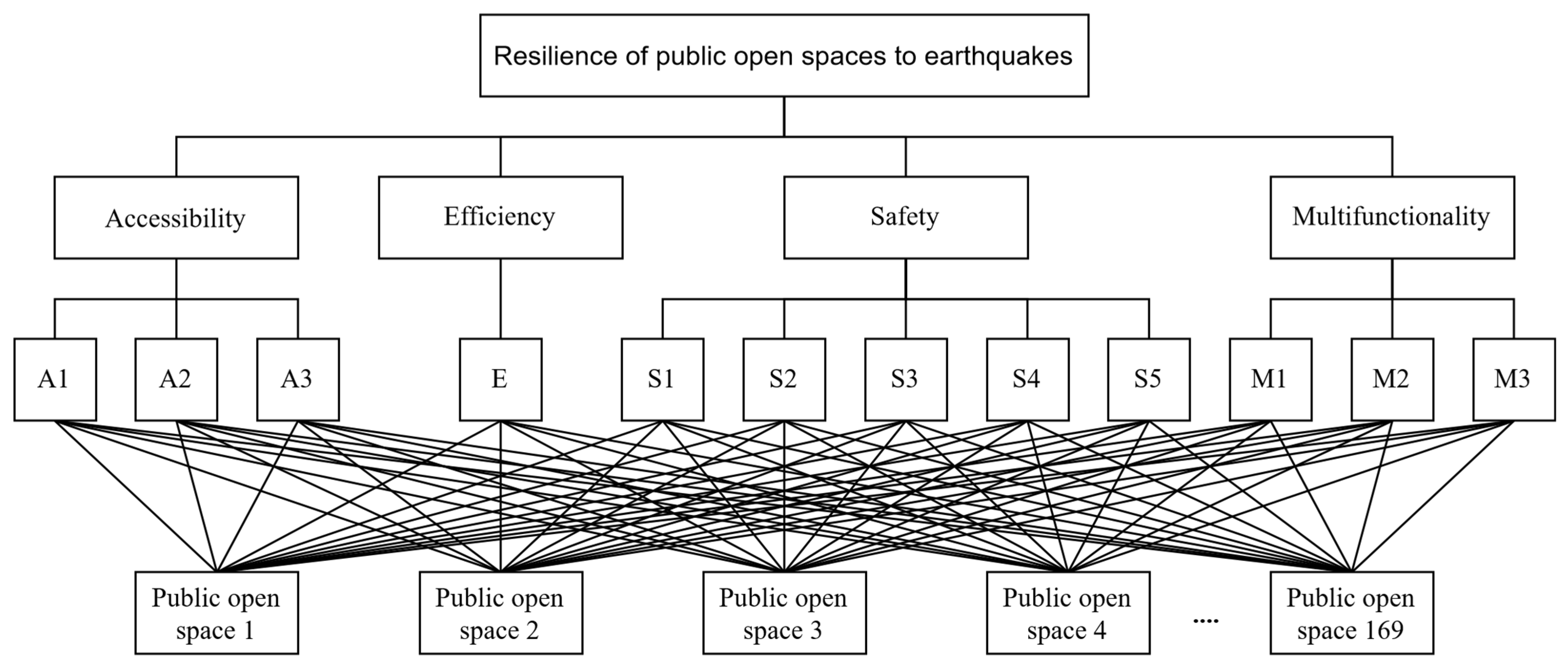
3. Results and Discussion
3.1. Evaluating the Earthquake Resilience Criteria
3.1.1. Accessibility
3.1.2. Efficiency
3.1.3. Safety
3.1.4. Multifunctionality
3.2. Measuring the Resilience Degree of POSs
3.3. Need to Improve Earthquake Resilience in POSs
- Improve the accessibility network by taking into account the geographical characteristics of the area to ensure rapid access to POSs during earthquakes and avoid disturbances in transportation and evacuation that increase losses caused by earthquakes.
- Create more POSs by considering the equity in the distribution of POSs between the various areas according to the population density to ensure the ability of POSs to accommodate those affected by the earthquake in the neighboring areas.
- Take safety priority into account when selecting POSs’ locations to avoid secondary hazards following earthquakes, especially the building collapse hazard, which is the greatest safety threat to using Chongqing’s POSs during earthquakes.
- Enhance services in POSs to increase their daily use and provide the basic needs of refugees affected by the earthquake. The response of POSs to earthquakes is more effective if they are incorporated into daily life [70].
- Given the rapid urbanization and continual adjustments in Chongqing, it is suggested to re-evaluate POSs every five years.
4. Conclusions
5. Limitations and Future Research Recommendations
Author Contributions
Funding
Institutional Review Board Statement
Informed Consent Statement
Data Availability Statement
Conflicts of Interest
References
- Childers, D.L.; Cadenasso, M.L.; Grove, J.M.; Marshall, V.; McGrath, B.; Pickett, S.T. An ecology for cities: A transformational nexus of design and ecology to advance climate change resilience and urban sustainability. Sustainability 2015, 7, 3774–3791. [Google Scholar] [CrossRef]
- Hossain, N. Street’as accessible open space network in earthquake recovery planning in unplanned urban areas. Asian J. Humanit. Soc. Sci. 2014, 2, 103–115. [Google Scholar]
- Parizi, S.M.; Taleai, M.; Sharifi, A. A GIS-Based Multi-Criteria Analysis Framework to Evaluate Urban Physical Resilience against Earthquakes. Sustainability 2022, 14, 5034. [Google Scholar] [CrossRef]
- UNISDR. How Can We Make Earthquakes Less Deadly? Available online: https://www.undrr.org/ (accessed on 25 April 2022).
- World Bank; United Nations. Natural Hazards, Unnatural Disasters: The Economics of Effective Prevention; World Bank: Washington, DC, USA, 2010. [Google Scholar]
- Allan, P.; Bryant, M. Resilience as a framework for urbanism and recovery. J. Landsc. Archit. 2011, 6, 34–45. [Google Scholar] [CrossRef]
- Nigg, J.M.; Eisner, R.K. Earthquake response: Intergovernmental structure and policy innovation. In University of Delaware Disaster Research Center Preliminary Paper; Disaster Research Center: Newark, DE, USA, 1997. [Google Scholar]
- Masuda, N. Disaster refuge and relief urban park system in Japan. Landsc. Archit. Front. 2014, 2, 52–61. [Google Scholar]
- Allan, P.; Bryant, M. The attributes of resilience: A tool in the evaluation and design of earthquake-prone cities. Int. J. Disaster Resil. Built Environ. 2014, 5, 109–129. [Google Scholar] [CrossRef]
- Greely, A.W.; Maj, G. Earthquake in California, April 18, 1906: Special Report of Maj. Gen. Adolphus W. Greely, U.S.A., Commanding the Pacifc Division; The Bancroft Library: Berkeley, CA, USA; University of California: Berkeley, CA, USA, 1906. [Google Scholar]
- Villagra, P.; Rojas, C.; Ohno, R.; Xue, M.; Gómez, K. A GIS-base exploration of the relationships between open space systems and urban form for the adaptive capacity of cities after an earthquake: The cases of two Chilean cities. Appl. Geogr. 2014, 48, 64–78. [Google Scholar] [CrossRef]
- You, C.; Chen, X.; Yao, L. How China responded to the May 2008 earthquake during the emergency and rescue period. J. Public Health Policy 2009, 30, 379–394. [Google Scholar] [CrossRef]
- Allan, P.; Bryant, M.; Wirsching, C.; Garcia, D.; Teresa Rodriguez, M. The influence of urban morphology on the resilience of cities following an earthquake. J. Urban Des. 2013, 18, 242–262. [Google Scholar] [CrossRef]
- Chelleri, L. From the «Resilient City» to Urban Resilience. A review essay on understanding and integrating the resilience perspective for urban systems. Doc. D’anàlisi Geogràfica 2012, 58, 287–306. [Google Scholar] [CrossRef]
- Ribeiro, P.J.G.; Gonçalves, L.A.P.J. Urban resilience: A conceptual framework. Sustain. Cities Soc. 2019, 50, 101625. [Google Scholar] [CrossRef]
- Timmermann, P. Vulnerability, resilience and the collapse of society. Environ. Monogr. 1981, 1, 1–42. [Google Scholar]
- Sharifi, A. Urban resilience assessment: Mapping knowledge structure and trends. Sustainability 2020, 12, 5918. [Google Scholar] [CrossRef]
- Jayakody, R.; Amaratunga, D.; Haigh, R. The Use of Public Open Spaces for Disaster Resilient Urban Cities; IIIRR: Kandy, Sri Lanka, 2016. [Google Scholar]
- Villagra-Islas, P.; Alves, S. Open space and their attributes, uses and restorative qualities in an earthquake emergency scenario: The case of Concepción, Chile. Urban For. Urban Green. 2016, 19, 56–67. [Google Scholar] [CrossRef]
- Covatta, A.; Ikalović, V. Urban Resilience: A Study of Leftover Spaces and Play in Dense City Fabric. Sustainability 2022, 14, 13514. [Google Scholar] [CrossRef]
- UNISDR. Hyogo framework for action 2005–2015. Encycl. Earth Sci. Ser. 2005, 380, 508–516. [Google Scholar] [CrossRef]
- United Nations. The 2030 Agenda for Sustainable Development; United Nations: New York, NY, USA, 2015.
- UNISDR. Sendai Framework for Disaster Risk Reduction 2015–2030. Available online: http://www.wcdrr.org/uploads/Sendai_Framework_for_Disaster_Risk_Reduction_2015-2030.pdf (accessed on 10 June 2021).
- Koren, D.; Rus, K. The potential of open space for enhancing urban seismic resilience: A literature review. Sustainability 2019, 11, 5942. [Google Scholar] [CrossRef]
- Bryant, M.; Allan, P. Designing Regional Resilience. In Proceedings of the NZSEE Annual Technical Conference, Rotorua, New Zealand, 10–12 April 2015. [Google Scholar]
- Gould, P.R. Spatial Diffusion, Resource Paper No. 4; Association of American Geographers; Commission on College Geography: Washington, DC, USA, 1969. [Google Scholar]
- Chang, H.-S.; Liao, C.-H. Planning emergency shelter locations based on evacuation behavior. Nat. Hazards 2015, 76, 1551–1571. [Google Scholar] [CrossRef]
- Nicholls, S. Measuring the accessibility and equity of public parks: A case study using GIS. Manag. Leis. 2001, 6, 201–219. [Google Scholar] [CrossRef]
- Yin, H.; Xu, J. Measuring the accessibility of parks: A case study in Shanghai, China. In Proceedings of the 2009 Sixth International Conference on Fuzzy Systems and Knowledge Discovery, Tianjin, China, 14–16 August 2009; pp. 232–236. [Google Scholar]
- Caiado, G.; Macário, R.; Oliveira, C.S. A New Paradigm in Urban Road Network Seismic Vulnerability: From a Link-By-Link Structural Approach to an Integrated Functional Assessment. In Proceedings of the ISCRAM, Lisbon, Portugal, 8–11 May 2011; Available online: https://idl.iscram.org/files/caiado/2011/360_Caiado_etal2011.pdf (accessed on 15 February 2022).
- Lam, C.; Shimizu, T. A network analytical framework to analyze infrastructure damage based on earthquake cascades: A study of earthquake cases in Japan. Int. J. Disaster Risk Reduct. 2021, 54, 102025. [Google Scholar] [CrossRef]
- Cova, T.J.; Johnson, J.P. Microsimulation of neighborhood evacuations in the urban–wildland interface. Environ. Plan. A 2002, 34, 2211–2229. [Google Scholar] [CrossRef]
- Kar, B.; Hodgson, M.E. A GIS-based model to determine site suitability of emergency evacuation shelters. Trans. GIS 2008, 12, 227–248. [Google Scholar] [CrossRef]
- El-Maissi, A.M.; Argyroudis, S.A.; Kassem, M.M.; Leong, L.V.; Mohamed Nazri, F. An Integrated Framework for the Quantification of Road Network Seismic Vulnerability and Accessibility to Critical Services. Sustainability 2022, 14, 12474. [Google Scholar] [CrossRef]
- Macintyre, A.G.; Barbera, J.A.; Smith, E.R. Surviving collapsed structure entrapment after earthquakes: A “time-to-rescue” analysis. Prehosp. Disaster Med. 2006, 21, 4–17. [Google Scholar] [CrossRef]
- Gall, M. Where to go? Strategic modelling of access to emergency shelters in Mozambique. Disasters 2004, 28, 82–97. [Google Scholar] [CrossRef] [PubMed]
- Tai, C.-A.; Lee, Y.-L.; Lin, C.-Y. Earthquake disaster prevention area planning considering residents’ demand. In Proceedings of the 2010 2nd International Conference on Advanced Computer Control, Shenyang, China, 27–29 March 2010; pp. 381–385. [Google Scholar]
- Zhan, F.B.; Noon, C.E. Shortest path algorithms: An evaluation using real road networks. Transp. Sci. 1998, 32, 65–73. [Google Scholar] [CrossRef]
- Hamza-Lup, G.L.; Hua, K.A.; Lee, M.; Peng, R. Enhancing intelligent transportation systems to improve and support homeland security. In Proceedings of the 7th International IEEE Conference on Intelligent Transportation Systems (IEEE cat. No. 04TH8749), Washington, WA, USA, 3–6 October 2004; pp. 250–255. [Google Scholar]
- Jotshi, A.; Gong, Q.; Batta, R. Dispatching and routing of emergency vehicles in disaster mitigation using data fusion. Socio-Econ. Plan. Sci. 2009, 43, 1–24. [Google Scholar] [CrossRef]
- Uno, K.; Kashiyama, K. Development of simulation system for the disaster evacuation based on multi-agent model using GIS. Tsinghua Sci. Technol. 2008, 13, 348–353. [Google Scholar] [CrossRef]
- Ministry of Housing and Urban-Rural Development of the People’s Republic of China. Standard for Urban Planning on Comprehensive Disaster Resistance and Prevention (GB/T 51327-2018). Available online: https://www.mohurd.gov.cn/gongkai/fdzdgknr/tzgg/201903/20190320_239841.html (accessed on 27 April 2022). (In Chinese)
- Ministry of Housing and Urban-Rural Development of the People’s Republic of China. Code for Design of Disasters Mitigation Emergency Congregate Shelter (GB 51143-2015). Available online: https://www.mohurd.gov.cn/gongkai/fdzdgknr/zfhcxjsbwj/202205/20220510_765998.html (accessed on 12 April 2022). (In Chinese)
- Wang, X. Research on the Suitability of the Emergency Shelter in Tianjin. In Proceedings of the 5th Annual International Conference on Social Science and Contemporary Humanity Development (SSCHD 2019), Wuhan, China, 15–16 November 2019; pp. 121–126. [Google Scholar]
- Zhao, L.; Li, H.; Sun, Y.; Huang, R.; Hu, Q.; Wang, J.; Gao, F. Planning emergency shelters for urban disaster resilience: An integrated location-allocation modeling approach. Sustainability 2017, 9, 2098. [Google Scholar] [CrossRef]
- Dionísio, M.R. The Importance of Public Space for Sustainable Urban Rehabilitation. In Proceedings of the Constructed Environment International Conference, Tokyo, Japan, 17–19 November 2010. [Google Scholar]
- Ishikawa, M. Landscape planning for a safe city. Ann. Geophys. 2002, 45, 833–841. [Google Scholar] [CrossRef]
- Chou, J.-S.; Ou, Y.-C.; Cheng, M.-Y.; Lee, C.-M. Emergency shelter capacity estimation by earthquake damage analysis. Nat. Hazards 2013, 65, 2031–2061. [Google Scholar] [CrossRef]
- Johnson, C. Strategic planning for post-disaster temporary housing. Disasters 2007, 31, 435–458. [Google Scholar] [CrossRef]
- Lizarralde, G.; Johnson, C.; Davidson, C. Rebuilding after Disasters: From Emergency to Sustainability; Routledge: London, UK, 2009. [Google Scholar]
- Félix, D.; Branco, J.M.; Feio, A. Temporary housing after disasters: A state of the art survey. Habitat Int. 2013, 40, 136–141. [Google Scholar] [CrossRef]
- Kreimer, A. Emergency, temporary and permanent housing after disasters in developing countries. Ekistics 1979, 46, 361–365. [Google Scholar]
- Liangxin, F.; Sha, X.; Guobin, L. Patterns and its disaster shelter of urban green space: Empirical evidence from Jiaozuo city, China. Afr. J. Agric. Res. 2012, 7, 1184–1191. [Google Scholar] [CrossRef]
- Tong, Z.; Zhang, J.; Liu, X. GIS-based design of urban emergency shelter in Songbei Harbin. In Recent Advances in Computer Science and Information Engineering; Springer: Berlin/Heidelberg, Germany, 2012; pp. 617–622. [Google Scholar]
- Sphere Association. Sphere Handbook: Humanitarian Charter and Minimum Standards in Humanitarian Response; Practical Action: Geneva, Switzerland, 2018. [Google Scholar]
- Sanderson, D.; Burnell, J. Beyond Shelter after Disaster: Practice, Process and Possibilities; Routledge: London, UK, 2013. [Google Scholar]
- Quarantelli, E.L. Patterns of sheltering and housing in US disasters. Disaster Prev. Manag. Int. J. 1995, 4, 43–53. [Google Scholar] [CrossRef]
- Chen, W.; Zhai, G.; Ren, C.; Shi, Y.; Zhang, J. Urban resources selection and allocation for emergency shelters: In a multi-hazard environment. Int. J. Environ. Res. Public Health 2018, 15, 1261. [Google Scholar] [CrossRef]
- Song, Y.; Xie, K.; Su, W. Mechanism and strategies of post-earthquake evacuation based on cellular automata model. Int. J. Disaster Risk Reduct. 2019, 34, 220–231. [Google Scholar] [CrossRef]
- Soltani, A.; Ardalan, A.; Boloorani, A.D.; Haghdoost, A.; Hosseinzadeh-Attar, M.J. Site selection criteria for sheltering after earthquakes: A systematic review. PLoS Curr. 2014, 6, 1–12. [Google Scholar] [CrossRef]
- Liu, K. GIS-based MCDM framework combined with coupled multi-hazard assessment for site selection of post-earthquake emergency medical service facilities in Wenchuan, China. Int. J. Disaster Risk Reduct. 2022, 73, 102873. [Google Scholar] [CrossRef]
- McGlynn, S.; Smith, G.; Alcock, A.; Murrain, P.; Bentley, I. Responsive Environments; Routledge: London, UK, 2013. [Google Scholar]
- Ghavampour, E. The Contribution of Natural Design Elements to the Sustained Use of Public Space in a City Centre; Victoria University of Wellington: Wellington, New Zealand, 2014. [Google Scholar]
- Tucker, P.; Gilliland, J.; Irwin, J.D. Splashpads, swings, and shade. Can. J. Public Health 2007, 98, 198–202. [Google Scholar] [CrossRef] [PubMed]
- Lloyd, K.; Burden, J.; Kiewa, J. Young Girls and Urban Parks: Planning for Transition Through Adolescence. J. Park Recreat. Adm. 2008, 26, 21–38. [Google Scholar]
- Ries, A.V.; Voorhees, C.C.; Roche, K.M.; Gittelsohn, J.; Yan, A.F.; Astone, N.M. A quantitative examination of park characteristics related to park use and physical activity among urban youth. J. Adolesc. Health 2009, 45, S64–S70. [Google Scholar] [CrossRef] [PubMed]
- Carmona, M.; De Magalhaes, C.; Hammond, L. Public Space: The Management Dimension; Routledge: London, UK, 2008. [Google Scholar]
- León, J.; March, A. Urban morphology as a tool for supporting tsunami rapid resilience: A case study of Talcahuano, Chile. Habitat Int. 2014, 43, 250–262. [Google Scholar] [CrossRef]
- Selman, P. Planning for landscape multifunctionality. Sustain. Sci. Pract. Policy 2009, 5, 45–52. [Google Scholar] [CrossRef]
- Mazereeuw, M.; Yarina, E. Emergency preparedness hub: Designing decentralized systems for disaster resilience. J. Archit. Educ. 2017, 71, 65–72. [Google Scholar] [CrossRef]
- Turer Baskaya, F.A. Disaster sensitive landscape planning for the coastal megacity of Istanbul. J. Coast. Conserv. 2015, 19, 729–742. [Google Scholar] [CrossRef]
- Chongqing Municipal Bureau of Statistics. The Statistical Bulletin of Chongqing’s National Economic and Social Development. 2021. Available online: https://m.gmw.cn/baijia/2022-03/18/1302851649.html (accessed on 17 May 2022). (In Chinese).
- Statistics Bureau of Yuzhong District, Chongqing. The National Population Census of Yuzhong District, Chongqing. 2021. Available online: http://www.cqyz.gov.cn/bm_229/qtjj/zwgk_97157/fdzdgknr_97159/tjxx_97164/202109/t20210918_9731956.html?UG8KLH=E6NKOC (accessed on 17 May 2022). (In Chinese)
- Statistics Bureau of Shapingba District, Chongqing. The National Population Census of Shapingba District, Chongqing. 2021. Available online: http://www.cqspb.gov.cn/bm/qtjj_64050/zwgk_64054/fdzdgknr_64056/tjzl/tjgb/202107/t20210701_9440993.html (accessed on 17 May 2022). (In Chinese)
- Clarke, K.C. Analytical and Computer Cartography; Prentice Hall: Englewood Cliffs, NJ, USA, 1995. [Google Scholar]
- Kakumoto, S.; Kosugi, Y.; Hatayama, M.; Kameda, H. Development of spatial temporal geographic information system and risk adaptive regional management information system-toward development of GIS based on Asian culture for disaster prevention. In Proceedings of the 41st SICE Annual Conference, Osaka, Japan, 5–7 August 2002; SICE 2002: New York, NY, USA, 2010; pp. 352–357. [Google Scholar]
- Saaty, T.L. Decision making with the analytic hierarchy process. Int. J. Serv. Sci. 2008, 1, 83–98. [Google Scholar] [CrossRef]
- Zabihi, H.; Alizadeh, M.; Kibet Langat, P.; Karami, M.; Shahabi, H.; Ahmad, A.; Nor Said, M.; Lee, S. GIS Multi-Criteria Analysis by Ordered Weighted Averaging (OWA): Toward an integrated citrus management strategy. Sustainability 2019, 11, 1009. [Google Scholar] [CrossRef]
- Rana, V.K.; Suryanarayana, T.M.V. GIS-based multi criteria decision making method to identify potential runoff storage zones within watershed. Ann. GIS 2020, 26, 149–168. [Google Scholar] [CrossRef]
- de Brito, M.M.; Evers, M. Multi-criteria decision-making for flood risk management: A survey of the current state of the art. Nat. Hazards Earth Syst. Sci. 2016, 16, 1019–1033. [Google Scholar] [CrossRef]
- Şenik, B.; Uzun, O. An assessment on size and site selection of emergency assembly points and temporary shelter areas in Düzce. Nat. Hazards 2021, 105, 1587–1602. [Google Scholar] [CrossRef]
- Junian, J.; Azizifar, V. The evaluation of temporary shelter areas locations using geographic information system and analytic hierarchy process. Civ. Eng. J. 2018, 4, 1678–1688. [Google Scholar] [CrossRef]
- Nuthammachot, N.; Stratoulias, D. Multi-criteria decision analysis for forest fire risk assessment by coupling AHP and GIS: Method and case study. Environ. Dev. Sustain. 2021, 23, 17443–17458. [Google Scholar] [CrossRef]
- Aman, D.D.; Aytac, G. Multi-criteria decision making for city-scale infrastructure of post-earthquake assembly areas: Case study of Istanbul. Int. J. Disaster Risk Reduct. 2022, 67, 102668. [Google Scholar] [CrossRef]
- Hoque, M.A.-A.; Tasfia, S.; Ahmed, N.; Pradhan, B. Assessing spatial flood vulnerability at Kalapara Upazila in Bangladesh using an analytic hierarchy process. Sensors 2019, 19, 1302. [Google Scholar] [CrossRef]
- Ramanathan, R. Data envelopment analysis for weight derivation and aggregation in the analytic hierarchy process. Comput. Oper. Res. 2006, 33, 1289–1307. [Google Scholar] [CrossRef]
- Mabahwi, N.A.B.; Bhattacharya, Y.; Nakamura, H. GIS-based multi-criteria analysis to identify site suitability of flood shelters in Kuantan, Malaysia. In Proceedings of the IOP Conference Series: Earth and Environmental Science, Surabaya, Indonesia, 30 November 2020; p. 012027. [Google Scholar]
- Şentürk, E.; Erener, A. Determination of temporary shelter areas in natural disasters by gis: A case study, Gölcük/Turkey. Int. J. Eng. Geosci. 2017, 2, 84–90. [Google Scholar] [CrossRef]
- Anhorn, J.; Khazai, B. Open space suitability analysis for emergency shelter after an earthquake. Nat. Hazards Earth Syst. Sci. 2015, 15, 789–803. [Google Scholar] [CrossRef]
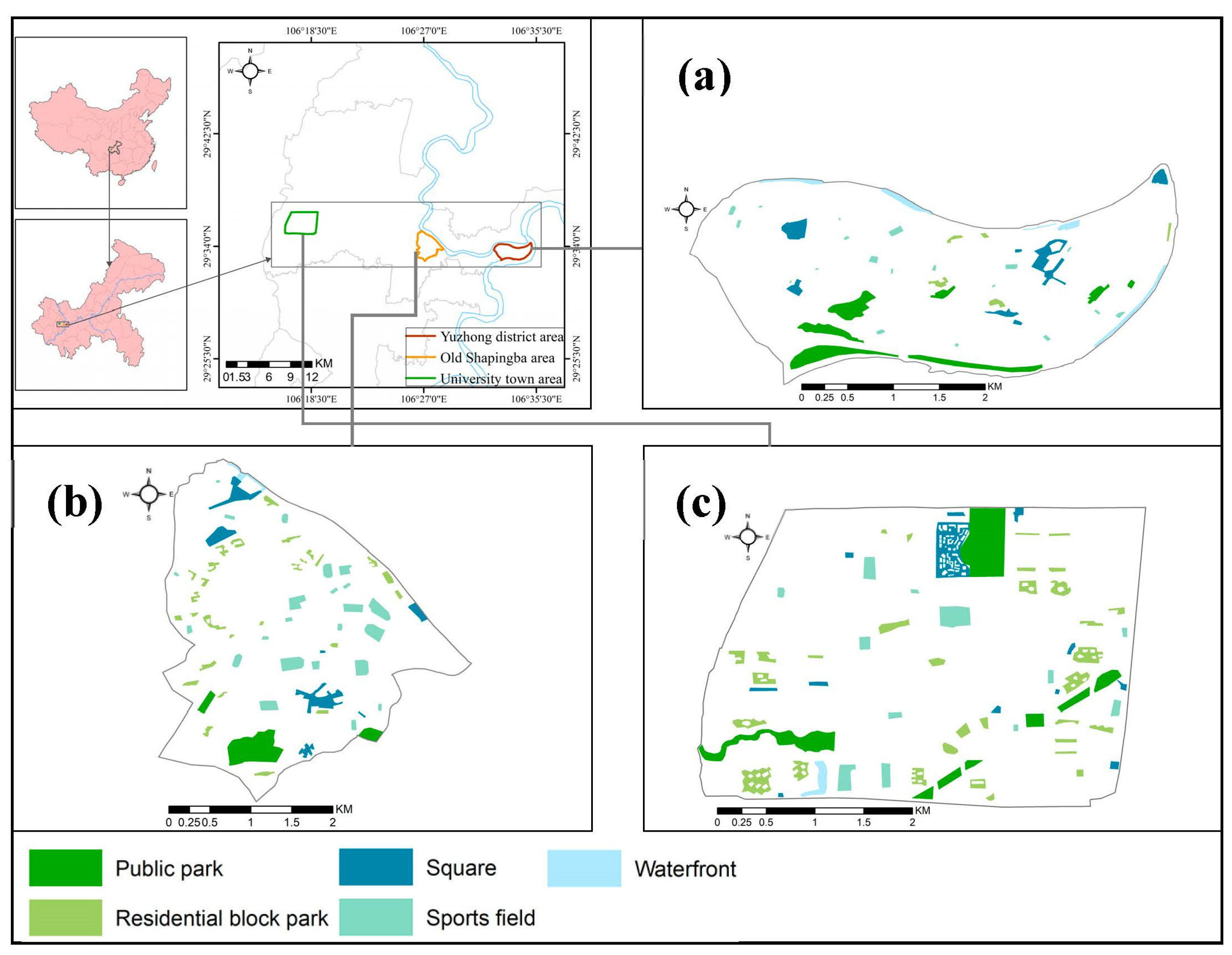
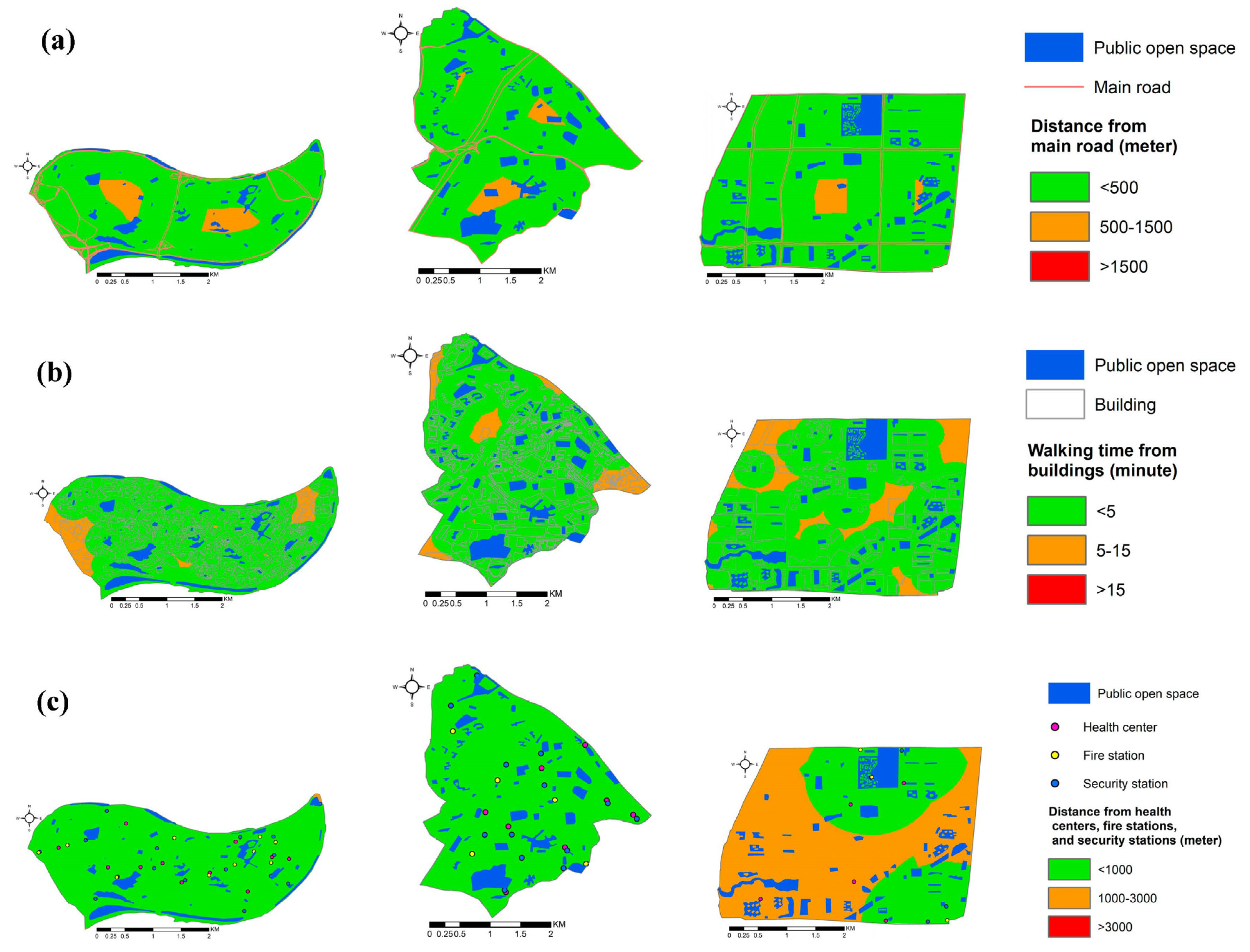

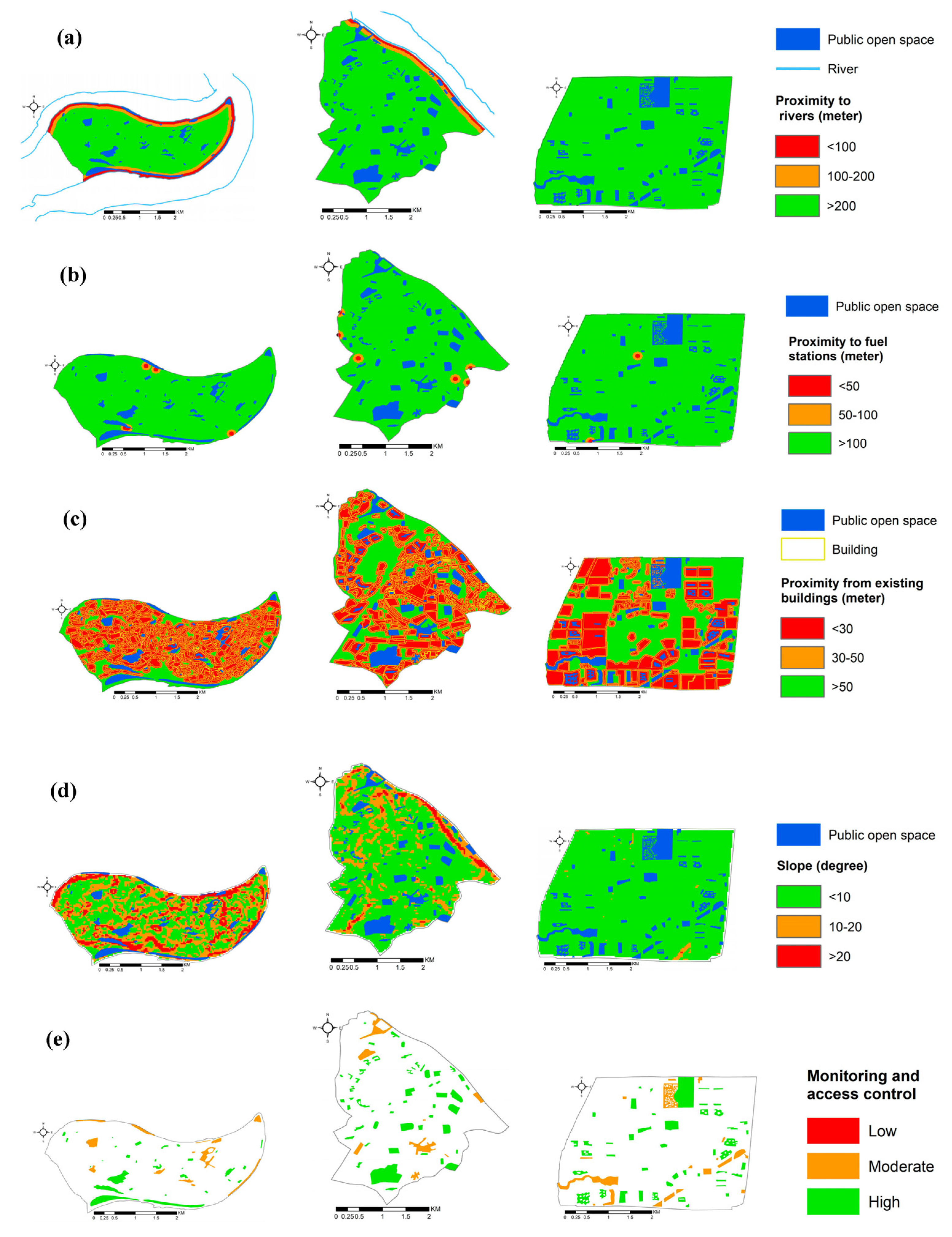


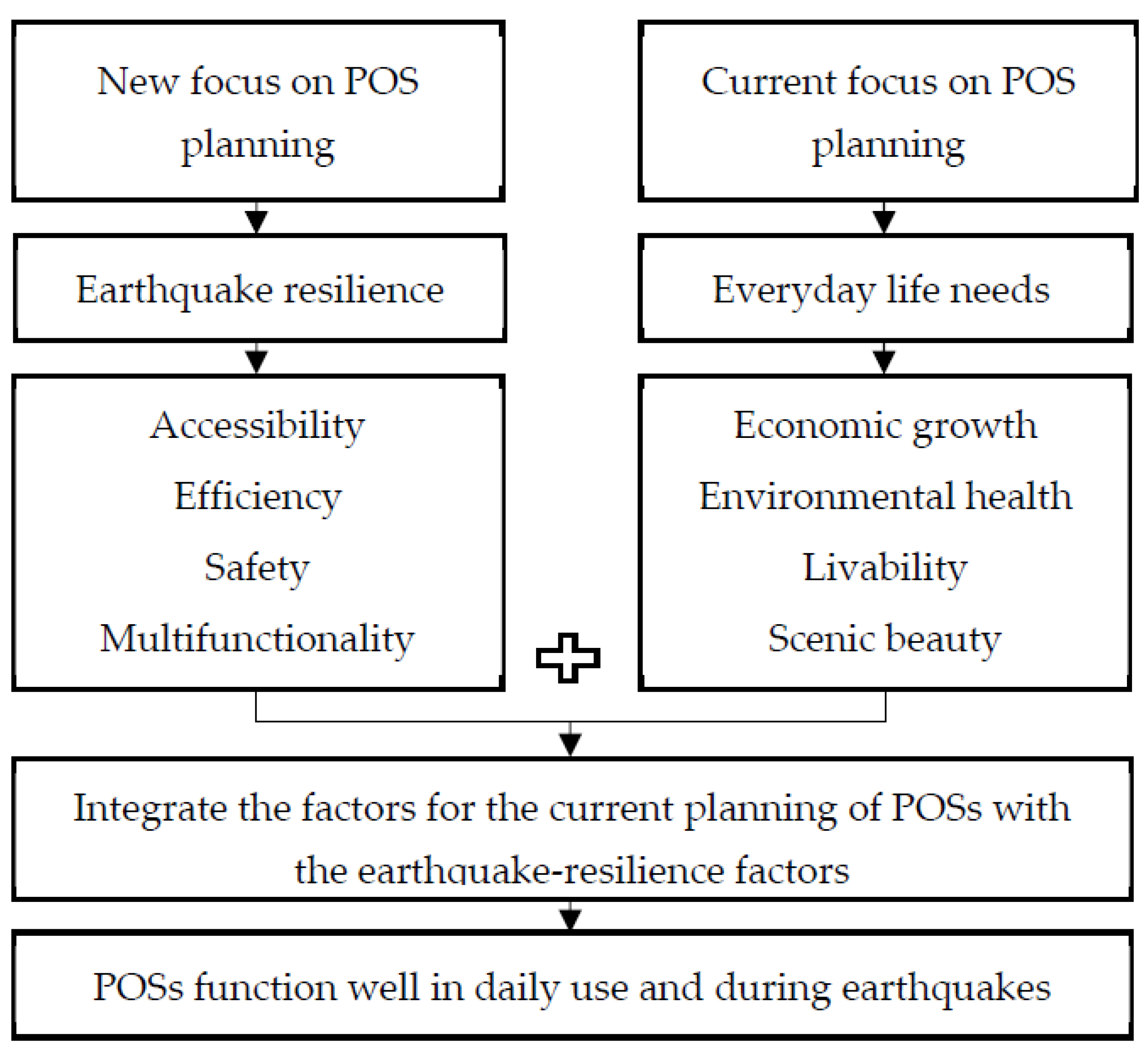
| Main Criteria | Sub-Criteria | Norm | Description |
|---|---|---|---|
| Accessibility | Distance from main roads | <500 m | Suitable |
| 500–1500 m | Neutral | ||
| >1500 m | Vulnerable | ||
| Walking time from buildings | <5 min | Suitable | |
| 5–15 m | Neutral | ||
| >15 m | Vulnerable | ||
| Distance from service centers | <1000 m | Suitable | |
| 1000–3000 m | Neutral | ||
| >3000 m | Vulnerable | ||
| Efficiency | Usable size | <2000 m2 | Emergency shelter |
| 2000–50,000 m2 | Temporary shelter | ||
| >50,000 m2 | Long term shelter | ||
| Safety | Proximity to flood sources | <100 m | Vulnerable |
| 100–200 m | Neutral | ||
| >200 m | Suitable | ||
| Proximity to fuel stations | <50 m | Vulnerable | |
| 50–100 m | Neutral | ||
| >100 m | Suitable | ||
| Building collapse hazards | <30 m | Vulnerable | |
| 30–50 m | Neutral | ||
| >50 m | Suitable | ||
| Slope | <10° | Suitable | |
| 10–20° | Neutral | ||
| >20° | Vulnerable | ||
| Monitoring and access control | Low | Vulnerable | |
| Moderate | Neutral | ||
| High | Suitable | ||
| Multifunctionality | Services | Low | Vulnerable |
| Moderate | Neutral | ||
| High | Suitable | ||
| Presence of large and dense trees | Low | Suitable | |
| Moderate | Neutral | ||
| High | Vulnerable | ||
| Daily use | Low | Vulnerable | |
| Moderate | Neutral | ||
| High | Suitable |
| A1 | A2 | A3 | E | S1 | S2 | S3 | S4 | S5 | M1 | M2 | M3 | |
|---|---|---|---|---|---|---|---|---|---|---|---|---|
| A1 | 1 | 0.25 | 1.00 | 0.25 | 0.25 | 0.25 | 0.25 | 0.50 | 1.00 | 0.50 | 0.50 | 0.50 |
| A2 | 4.00 | 1 | 4.00 | 1.00 | 1.00 | 1.00 | 1.00 | 2.00 | 4.00 | 2.00 | 2.00 | 2.00 |
| A3 | 1.00 | 0.25 | 1 | 0.25 | 0.25 | 0.25 | 0.25 | 0.50 | 1.00 | 0.50 | 0.50 | 0.50 |
| E | 4.00 | 1.00 | 4.00 | 1 | 1.00 | 1.00 | 1.00 | 2.00 | 4.00 | 2.00 | 2.00 | 2.00 |
| S1 | 4.00 | 1.00 | 4.00 | 1.00 | 1 | 1.00 | 1.00 | 2.00 | 4.00 | 2.00 | 2.00 | 2.00 |
| S2 | 4.00 | 1.00 | 4.00 | 1.00 | 1.00 | 1 | 1.00 | 2.00 | 4.00 | 2.00 | 2.00 | 2.00 |
| S3 | 4.00 | 1.00 | 4.00 | 1.00 | 1.00 | 1.00 | 1 | 2.00 | 4.00 | 2.00 | 2.00 | 2.00 |
| S4 | 2.00 | 0.50 | 2.00 | 0.50 | 0.50 | 0.50 | 0.50 | 1 | 2.00 | 1.00 | 1.00 | 1.00 |
| S5 | 1.00 | 0.25 | 1.00 | 0.25 | 0.25 | 0.25 | 0.25 | 0.50 | 1 | 0.50 | 0.50 | 0.50 |
| M1 | 2.00 | 0.50 | 2.00 | 0.50 | 0.50 | 0.50 | 0.50 | 1.00 | 2.00 | 1 | 1.00 | 1.00 |
| M2 | 2.00 | 0.50 | 2.00 | 0.50 | 0.50 | 0.50 | 0.50 | 1.00 | 2.00 | 1.00 | 1 | 1.00 |
| M3 | 2.00 | 0.50 | 2.00 | 0.50 | 0.50 | 0.50 | 0.50 | 1.00 | 2.00 | 1.00 | 1.00 | 1 |
| Resilience Criteria | Weights | Code | Sub-Criteria | Local Weights | Global Weights |
|---|---|---|---|---|---|
| Accessibility | 0.193 | A1 | Distance from main road | 0.1658 | 0.032 |
| A2 | Walking time from buildings | 0.668 | 0.129 | ||
| A3 | Distance from service centers | 0.1658 | 0.032 | ||
| Efficiency | 0.129 | E | Usable size | 0.129 | 0.129 |
| Safety | 0.484 | S1 | Proximity to flood sources | 0.2665 | 0.129 |
| S2 | Proximity to fuel stations | 0.2665 | 0.129 | ||
| S3 | Building collapse hazard | 0.2665 | 0.129 | ||
| S4 | Slope | 0.134 | 0.065 | ||
| S5 | Monitoring and access control | 0.066 | 0.032 | ||
| Multi- functionality | 0.195 | M1 | Services | 0.333 | 0.065 |
| M2 | Presence of large and dense trees | 0.333 | 0.065 | ||
| M3 | Daily use | 0.333 | 0.065 |
| Emergency Shelter | Temporary Shelter | Long Term Shelter | ||||
|---|---|---|---|---|---|---|
| POS Usable Size (m2) | Capacity (People) | POS Usable Size (m2) | Capacity (People) | POS Usable Size (m2) | Capacity (People) | |
| Yuzhong | 11,071.5 | 22,143 | 345,018.8 | 345,018 | 65,543.1 | 14,565 |
| Old Shapingba | 9903.1 | 19,806 | 549,611.6 | 549,611 | 86,765 | 19,281 |
| University town | 4896.4 | 9792 | 558,129 | 558,129 | 304,882.4 | 67,751 |
Disclaimer/Publisher’s Note: The statements, opinions and data contained in all publications are solely those of the individual author(s) and contributor(s) and not of MDPI and/or the editor(s). MDPI and/or the editor(s) disclaim responsibility for any injury to people or property resulting from any ideas, methods, instructions or products referred to in the content. |
© 2023 by the authors. Licensee MDPI, Basel, Switzerland. This article is an open access article distributed under the terms and conditions of the Creative Commons Attribution (CC BY) license (https://creativecommons.org/licenses/by/4.0/).
Share and Cite
Alawi, M.; Chu, D.; Hammad, S. Resilience of Public Open Spaces to Earthquakes: A Case Study of Chongqing, China. Sustainability 2023, 15, 1092. https://doi.org/10.3390/su15021092
Alawi M, Chu D, Hammad S. Resilience of Public Open Spaces to Earthquakes: A Case Study of Chongqing, China. Sustainability. 2023; 15(2):1092. https://doi.org/10.3390/su15021092
Chicago/Turabian StyleAlawi, Mohsen, Dongzhu Chu, and Seba Hammad. 2023. "Resilience of Public Open Spaces to Earthquakes: A Case Study of Chongqing, China" Sustainability 15, no. 2: 1092. https://doi.org/10.3390/su15021092
APA StyleAlawi, M., Chu, D., & Hammad, S. (2023). Resilience of Public Open Spaces to Earthquakes: A Case Study of Chongqing, China. Sustainability, 15(2), 1092. https://doi.org/10.3390/su15021092





